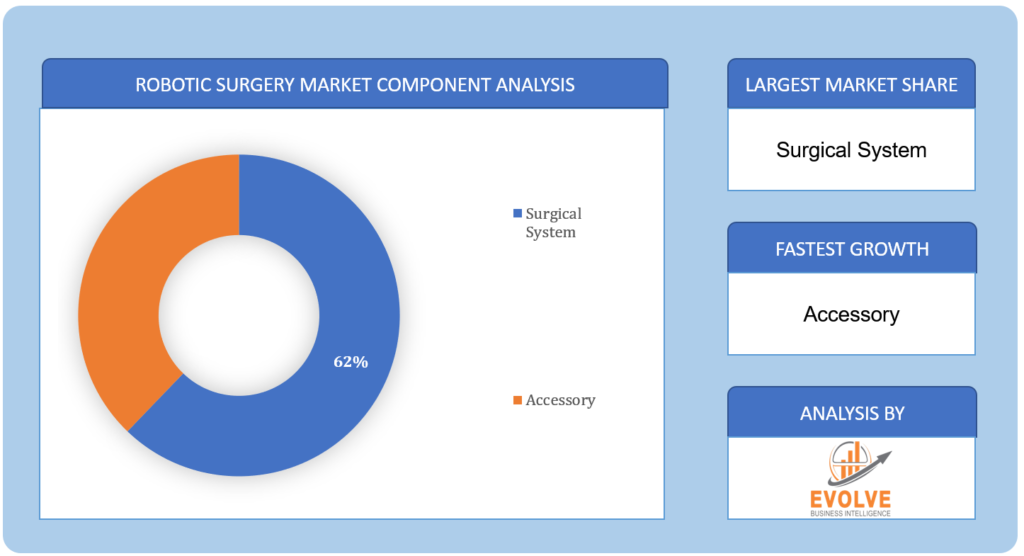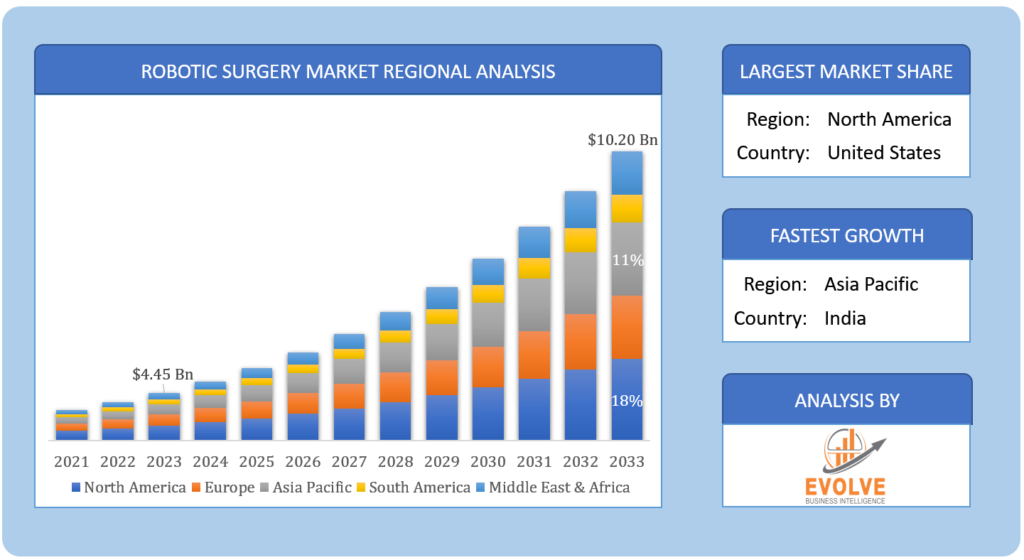Robotic Surgery Market Overview
The Robotic Surgery Market Size is expected to reach USD 10.20 Billion by 2033. The Robotic Surgery industry size accounted for USD 4.45 Billion in 2023 and is expected to expand at a CAGR of 18.21% from 2023 to 2033. Robotic surgery is a minimally invasive surgical technique that utilizes advanced robotic systems to assist surgeons in performing complex procedures with greater precision and control. It involves the use of robotic arms equipped with surgical instruments and a high-definition camera, which are controlled by a trained surgeon from a console. The surgeon’s precise movements are translated into real-time actions by the robot, allowing for smaller incisions, reduced tissue damage, and shorter recovery times for patients. Robotic surgery is commonly employed in various medical specialties, such as urology, gynecology, and general surgery, to enhance surgical outcomes and improve patient well-being.
Global Robotic Surgery Market Synopsis
The COVID-19 pandemic had a moderate impact on the robotic surgery market. While the pandemic initially disrupted elective surgeries and hospital operations, leading to a temporary slowdown in the adoption of robotic surgical systems, the long-term outlook for the industry remained positive. The need to minimize the risk of viral transmission and the increasing recognition of the benefits of minimally invasive procedures fueled a resurgence in demand for robotic surgery technologies. Hospitals and healthcare facilities increasingly invested in robotic systems to perform procedures with enhanced precision, reduced physical contact, and shorter hospital stays, ultimately driving the growth of the robotic surgery market, albeit with some temporary setbacks during the peak of the pandemic.
Robotic Surgery Market Dynamics
The major factors that have impacted the growth of Robotic Surgery are as follows:
Drivers:
Ø Advancements in Surgical Technology
The continuous development and integration of cutting-edge technologies in robotic surgical systems have been a significant driver for the robotic surgery market. Innovations such as improved imaging, haptic feedback, and artificial intelligence-driven assistance have enhanced the precision and capabilities of robotic platforms. Surgeons are increasingly adopting robotic surgery to perform complex procedures with greater accuracy, which is leading to improved patient outcomes. This technological progress is propelling the market’s growth as healthcare institutions seek to provide advanced surgical solutions.
Restraint:
- High Initial Costs and Maintenance Expenses
A notable restraint in the robotic surgery market is the high initial acquisition costs and ongoing maintenance expenses associated with robotic surgical systems. These costs can be substantial, making it a significant financial commitment for hospitals and healthcare facilities. The need for specialized training and support staff can further add to the financial burden. These barriers may limit the adoption of robotic surgery in smaller or underfunded healthcare institutions, potentially slowing the market’s growth, although cost-effectiveness and value over time are often cited as counterarguments.
Opportunity:
⮚ Expanding Applications and Specializations
An exciting opportunity in the robotic surgery market is the expansion of applications and specializations. While robotic surgery has gained prominence in areas like urology, gynecology, and general surgery, there is potential for growth in numerous other medical specialties. As robotic platforms become more versatile and adaptable, they are increasingly used in orthopedics, neurosurgery, and cardiac surgery, among others. This diversification of applications opens up new avenues for market expansion as healthcare providers seek to leverage the benefits of robotic systems across a broader range of surgical procedures.
Robotic Surgery Segment Overview
By Component
 Based on Components, the market is segmented based on Surgical Systems, and Accessories. The Surgical System segment is expected to experience significant growth throughout the forecast period in the Robotic Surgery market due to the increasing adoption of robotic-assisted surgery for its precision, minimally invasive benefits, and expanding applications across various medical specialties.
Based on Components, the market is segmented based on Surgical Systems, and Accessories. The Surgical System segment is expected to experience significant growth throughout the forecast period in the Robotic Surgery market due to the increasing adoption of robotic-assisted surgery for its precision, minimally invasive benefits, and expanding applications across various medical specialties.
By Service
Based on the Service, the market has been divided into Areas of Surgery, Gynecological Surgery, Cardiovascular, Neurosurgery, Orthopedic Surgery, Laparoscopy, Urology, and others. The Area of Surgery segment is poised for substantial growth in the Robotic Surgery market during the forecast period owing to the expanding utilization of robotic systems in diverse surgical specialties, ranging from urology and gynecology to orthopedics and cardiac surgery, enhancing patient outcomes and surgical precision.
Global Robotic Surgery Market Regional Analysis
Based on region, the global Robotic Surgery market has been divided into North America, Europe, Asia-Pacific, the Middle East & Africa, and Latin America. North America is projected to dominate the use of the Robotic Surgery market followed by the Asia-Pacific and Europe regions.
 North America Market
North America Market
North America has traditionally held a dominant position in the Robotic Surgery market. This leadership is primarily driven by the region’s early and extensive adoption of robotic surgical systems, a well-established healthcare infrastructure, and a high level of investment in medical technology. The United States, in particular, has been at the forefront of integrating robotic surgery into various medical specialties, with a significant number of hospitals and healthcare institutions investing in these advanced systems. Additionally, a supportive regulatory environment, strong research and development activities, and a well-trained workforce have further contributed to North America’s prominent role in shaping the growth of the robotic surgery market.
Asia-Pacific Market
The Asia-Pacific region has rapidly emerged as a thriving market for the Robotic Surgery industry. This surge in growth is driven by several key factors, including the increasing prevalence of chronic diseases, a rising aging population, and a growing demand for minimally invasive surgical procedures. The region’s healthcare infrastructure is continually improving, with a growing number of hospitals and medical centers incorporating robotic surgical systems to meet the demand for advanced healthcare solutions. Additionally, government initiatives, investments in medical technology, and a surge in healthcare expenditure are propelling the adoption of robotic surgery in countries like China, Japan, and South Korea. As the awareness of the benefits of robotic-assisted surgery spreads and access to these technologies expands, the Asia-Pacific region is positioned for substantial growth in the robotic surgery market.
Competitive Landscape
The Global Robotic Surgery market is highly competitive, with numerous players offering a wide range of solutions. The competitive landscape is characterized by the presence of established companies, as well as emerging startups and niche players. To increase their market position and attract a wide consumer base, the businesses are employing various strategies, such as product launches, and strategic alliances.
Prominent Players:
- Stryker Corporation
- Medrobotics
- Smith & Nephew
- TransEnterix Surgical, Inc
- Renishaw plc
- Intuitive Surgical
- Medtronic
- CMR Surgical
- THINK Surgical, Inc
- Zimmer Biomet
Key Development:
In June 2022, Stryker, a leading global medical technology company, unveiled its latest research and development hub, known as Stryker’s Global Technology Centre (SGTC), located within the International Tech Park in Gurgaon. This expansive 150,000-square-foot facility is poised to catalyze innovation, both within India and on a global scale, aligning with Stryker’s overarching commitment to advancing healthcare.
In June 2022, CMR Surgical (CMR) celebrated a significant milestone as its Versius Surgical Robotic System reached a remarkable benchmark, having been utilized in over 5,000 surgical procedures worldwide. This noteworthy achievement culminated at Argenteuil Hospital in Paris, France, where Dr. Patrick Bagan and his proficient team skillfully conducted a successful lung bi-segmentectomy to address a case of cancer, underscoring the global impact of this innovative surgical technology.
Scope of the Report
Global Robotic Surgery Market, by Component
- Surgical System
- Accessory
Global Robotic Surgery Market, by Service
- Area of Surgery
- Gynecological Surgery
- Cardiovascular
- Neurosurgery
- Orthopedic Surgery
- Laparoscopy
- Urology
- Other
Global Robotic Surgery Market, by Region
- North America
- US
- Canada
- Mexico
- Europe
- UK
- Germany
- France
- Italy
- Spain
- Benelux
- Nordic
- Rest of Europe
- Asia Pacific
- China
- Japan
- South Korea
- Indonesia
- Austalia
- Malaysia
- India
- Rest of Asia Pacific
- South America
- Brazil
- Argentina
- Rest of South America
- Middle East & Africa
- Saudi Arabia
- UAE
- Egypt
- South Africa
- Rest of Middle East & Africa
| Parameters | Indicators |
|---|---|
| Market Size | 2033: $10.20 Billion |
| CAGR | 18.21% CAGR (2023-2033) |
| Base year | 2022 |
| Forecast Period | 2023-2033 |
| Historical Data | 2021 |
| Report Coverage | Revenue Forecast, Competitive Landscape, Growth Factors, and Trends |
| Key Segmentations | Component, Service |
| Geographies Covered | North America, Europe, Asia-Pacific, Latin America, Middle East, Africa |
| Key Vendors | Stryker Corporation, Medrobotics, Smith & Nephew, TransEnterix Surgical, Inc, Renishaw plc, Intuitive Surgical, Medtronic, CMR Surgical, THINK Surgical, Inc, Zimmer Biomet |
| Key Market Opportunities | • Increasing opportunities for the adoption of robotic surgery • As awareness of the benefits of robotic-assisted surgery spreads |
| Key Market Drivers | • Precision and Minimally Invasive Benefits • Technological Advancements |
REPORT CONTENT BRIEF:
- High-level analysis of the current and future Robotic Surgery market trends and opportunities
- Detailed analysis of current market drivers, restraining factors, and opportunities in the future
- Robotic Surgery market historical market size for the year 2021, and forecast from 2023 to 2033
- Robotic Surgery market share analysis at each product level
- Competitor analysis with detailed insight into its product segment, Government and defense strength, and strategies adopted.
- Identifies key strategies adopted including product launches and developments, mergers and acquisitions, joint ventures, collaborations, and partnerships as well as funding taken and investment done, among others.
- To identify and understand the various factors involved in the global Robotic Surgery market affected by the pandemic
- To provide a detailed insight into the major companies operating in the market. The profiling will include the Government and defense health of the company’s past 2-3 years with segmental and regional revenue breakup, product offering, recent developments, SWOT analysis, and key strategies.







